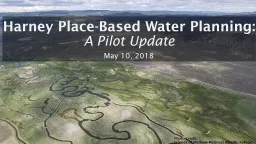

Photo Credit Friends of Malheur National Wildlife Refuge Harney PlaceBased Water Planning A Pilot Update May 10 2018 Where Are We Now An Overview A Collaborative Vision A sustainably managed supply of quality water for people the economy and the environment ID: 764137
Download Presentation The PPT/PDF document "Photo Credit: Friends of Malheur Nation..." is the property of its rightful owner. Permission is granted to download and print the materials on this web site for personal, non-commercial use only, and to display it on your personal computer provided you do not modify the materials and that you retain all copyright notices contained in the materials. By downloading content from our website, you accept the terms of this agreement.
Photo Credit: Friends of Malheur National Wildlife Refuge Harney Place-Based Water Planning: A Pilot Update May 10, 2018
Where Are We Now?: An Overview
A Collaborative Vision “A sustainably managed supply of quality water for people, the economy, and the environment.”
131 E-mail Listserve Subscribers 7 Quarterly Meetings since September 2016~30-60 people per meeting4 Currently Active Working GroupsAgricultureDomestic Well/Municipal WaterEcologyVegetation Management19 Working Group meetings, so far… ~15-20 people per meeting The Harney Basin Collaborative
Working on Step 2 and Step 3 Concurrently:Working Groups are continuing to research, compile, and synthesize existing technical information and local knowledge/expertiseFindings are shared with the full Collaborative through verbal updates and various deliverablesThe Harney Basin Collaborative
Working on Step 2 and Step 3 Concurrently:Working Groups are continuing to research, compile, and synthesize existing technical information and local knowledge/expertiseFindings are shared with the full Collaborative through verbal updates and various deliverablesWe receive quarterly updates and preliminary findings from the USGS/OWRD Groundwater Study and stay in communication with Groundwater Study Team Members in the interim The Harney Basin Collaborative
Working on Step 2 and Step 3 Concurrently:Working Groups are continuing to research, compile, and synthesize existing technical information and local knowledge/expertiseFindings are shared with the full Collaborative through verbal updates and various deliverablesWe receive quarterly updates and preliminary findings from the USGS/OWRD Groundwater Study and stay in communication with Groundwater Study Team Members in the interim Bonus Information: Harney County Court & Oregon Business Council are currently funding the first phase of a socioeconomic analysis around the value of water in the basinThe Harney Basin Collaborative
Step 1 - Building a Collaborative: Progress and Challenges
Clear call to actionKey Factors in Sustaining Interest Step 1:
Our Call to Action :Figure 1: Aquifer Recharge in Relation to Permitted and Estimated Water Use (from OWRD, 2016)
Clear call to actionKey Factors in Sustaining Interest Step 1:
Clear call to actionOpportunity to shape our water futureKey Factors in Sustaining Interest Step 1:
Personal outreach has been key to building and maintaining collaborative energy: One-on-one home visitsInformal coffee conversationsPhone calls, phone calls, phone calls Key Factors in Building a CollaborativeStep 1:
There is uncertainty about whether the Collaborative’s plan will have weightSome believe that there is already a pre-determined outcomeSome desire to have OWRD fix the problemChallenges in Building &Maintaining Collaborative Step 1:
Didn’t talk to enough (and diverse enough) local community membersBuilding respect and balanced representation takes timesThere are diverse interests, each of which is a priorityPeople tend to stay in their silosChallenges in Building &Maintaining Collaborative Step 1:
So where do we begin? Focus and integration:Conceptual Model developed with input from OSU hydrogeologistHelps identify keys areas where management solutions will have largest impactWorking Groups were formed around the Conceptual Model
131 E-mail Listserve Subscribers 7 Quarterly Meetings since September 2016~30-60 people per meeting4 Currently Active Working GroupsAgricultureDomestic Well/Municipal WaterEcologyVegetation Management19 Working Group meetings, so far… ~15-20 people per meeting It’s difficult, but people are showing up …
Step 2 - Building a Shared Understanding: Findings and Deliverables
Working Group Progress ReportsTwo-page summary of findings to dateIssue Backgrounders:AgricultureRural Domestic WellMunicipalWater Quality (in development)State of the Basin Report (in development, deliverable for Step 2)Deliverables: Information & Discussion Step 2
Water is over-appropriated2) Shared sacrifice will be required (there’s no way around it)3) The innovation needed for solutions may not be attainable under current rules/policy/law What We’ve Discovered: From The 30,000-Foot View Step 2:
The Overall Value of PBP for the Harney BasinThe investment into and new opportunities for our community Inclusion of diverse perspectives can provide ideas that are more robust and well thought out Higher potential for innovative solutionsCould yield real results and improved social, economic, and ecological resilience around water
Photo Credit: Friends of Malheur National Wildlife Refuge Thank you. Mark Owens: mark.owens@co.harney.or.us Brenda Smith: director@highdesertpartnership.org